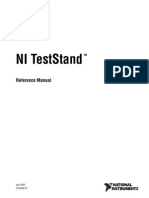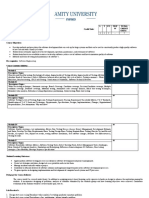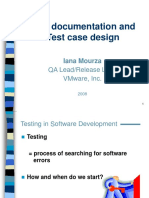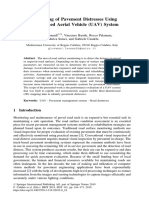W.E.F Academic Year 2012-13 G' Scheme
W.E.F Academic Year 2012-13 G' Scheme
Uploaded by
avani292005Copyright:
Available Formats
W.E.F Academic Year 2012-13 G' Scheme
W.E.F Academic Year 2012-13 G' Scheme
Uploaded by
avani292005Original Title
Copyright
Available Formats
Share this document
Did you find this document useful?
Is this content inappropriate?
Copyright:
Available Formats
W.E.F Academic Year 2012-13 G' Scheme
W.E.F Academic Year 2012-13 G' Scheme
Uploaded by
avani292005Copyright:
Available Formats
w.e.
f Academic Year 2012-13 ‘G’ Scheme
Course Name : Computer Engineering Group
Course Code : CO/CD/CM
Semester : Sixth for CO/CM and Seventh for CD
Subject Title : Software Testing
Subject Code : 17624
Teaching and Examination Scheme:
Teaching Scheme Examination Scheme
PAPER
TH TU PR TH PR OR TW TOTAL
HRS
03 -- 02 03 100 50# -- 25@ 175
NOTE:
Two tests each of 25 marks to be conducted as per the schedule given by MSBTE.
Total of tests marks for all theory subjects are to be converted out of 50 and to be
entered in mark sheet under the head Sessional Work (SW).
Rationale:
The complexity and size of today’s software makes writing secure, bug-free code is
extremely difficult, in such a situation testing of software before release is very essential. Software
testing can be considered as “Quality Gate” which will pass / release only quality software.
Students will learn how to find bugs/errors in any computer program, how to plan an effective test
approach, how to clearly report findings and to tell when software is ready to release. Also it
introduces various levels and types of testing so that students will be able to practically apply
appropriate testing method on application. It also covers manual testing as well as expanding
manual test efforts with various automation tools.
Objectives:
Students will be able to:
1. Understand how software testing fits into the software development process.
2. Learn various types and levels of software testing.
3. Develop the skills to find bugs in any type of software.
4. Learn how to effectively plan tests, communicate the bugs you find.
5. Use your new testing skill to test not just the software but also the product specification,
the raw code and even the user’s manual.
6. Understand STLC, test planning, test case writing and testing execution and defect
management.
7. Understand the various automated testing tools to improve testing efficiency.
MSBTE - Final Copy Dt. 21/11/2014 8 17624 CO6
w.e.f Academic Year 2012-13 ‘G’ Scheme
Learning Structure:
Testing application using manual automation methods,
Application improve efficiency of product.
Manual Test Procedure- (reading SRS planning test design test
case test execution bug report software release)
Procedure
Automation Tests- (selecting tool follow steps of selected
automated tools)
Principle Static Testing (Verification), Dynamic Testing (Validation),
Automation, Bug reporting (Defect management)
Facts Hardware, Software, Modules, SRS
MSBTE - Final Copy Dt. 21/11/2014 9 17624 CO6
w.e.f Academic Year 2012-13 ‘G’ Scheme
Theory:
Topic
Contents Hours Marks
No.
Basics of Software Testing
Objectives:
Understand the concept of Software Testing
Understand the importance of Quality Software
1.1 Software Quality, Definition of Software Testing, Role of Testing
1.2 Failure, Error, Fault, Defect, Bug Terminology
1 1.3 Objectives of Testing 04 10
1.4 Test Case
1.5 When to Start and Stop Testing of Software (Entry and Exit
Criteria)
1.6 Skills for Software Tester
1.7 Quality Assurance, Quality Control, Verification and Validation, V
Model
Types of Testing
Objectives:
Understand the basic types of testing for software.
Differentiate White box and Black box testing
2.1 White Box Testing : Classification of White Box Testing
1. Static Testing- Inspections, Structured Walkthroughs, Technical
Review
2 08 20
2. Structural Testing-Code Functional Testing, Code Coverage
Testing, Code Complexity Testing
2.1 Black Box Testing: Techniques for Black Box Testing
Requirement Based Testing, Positive and Negative Testing,
Boundary Value Analysis, Decision Tables, Equivalence
Partitioning, User Documentation Testing, Graph Based Testing.
Sample Examples on White and Black Box Testing.
Levels of Testing and Special Tests
Objectives :
Understand the various levels of testing.
Understand some of special tests.
3.1 Unit Testing: Driver, Stub
3.2 Integration Testing: Decomposition Based Testing - Top-Down
Integration, Bottom-Up Integration, Bi-Directional Integration,
Incremental Integration, Non-Incremental Integration
3 12 24
3.3 System Testing: Recovery Testing, Security Testing, Performance
Testing, Load Testing, Stress Testing, Usability Testing,
Compatibility Testing
3.4 Acceptance Testing: Acceptance criteria, Alpha Testing an Beta
Testing
3.5 Special Tests: Smoke Testing and Sanity Testing, Regression
Testing, Usability Testing, GUI Testing, Object Oriented
Application Testing: Client-Server Testing, Web based Testing
Test Management
Objectives:
4 Design and execute test cases. 12 20
Understand the Test Report Process for recommending the
product Understand the process of test planning.
MSBTE - Final Copy Dt. 21/11/2014 10 17624 CO6
w.e.f Academic Year 2012-13 ‘G’ Scheme
Identify resources for test plan implementation and decide
the staffing for release.
4.1 Test Planning : Preparing a Test Plan, Scope Management,
Deciding Test Approach, Setting Up Criteria for Testing,
Identifying Responsibilities, Staffing, Training Needs, Resource
Requirements, Test Deliverables, Testing Tasks
4.2 Test Management: Choice of Standards, Test Infrastructure
Management, Test People Management, Integrating with Product
Release
4.3 Test Process: Base Lining a Test Plan, Test Case Specification,
Update of Traceability
4.4 Test Reporting: Recommending Product Release. Matrix,
Executing Test Cases, Collecting and Analyzing Metrics,
Preparing Test Summary Report
Defect Management
Objectives:
Find, handle and report defect by using standard technique.
Understand the Defect life cycle.
5 06 14
5.1 Introduction, Defect Classification, Defect Management Process
5.2 Defect Life Cycle, Defect Template
5.3 Estimate Expected Impact of a Defect, Techniques for Finding
Defects, Reporting a Defect
Testing Tools and Measurements
Objectives:
Understand the shortcomings of manual testing.
Understand the use of automated test tools.
6.1 Limitations of Manual Testing and Need for Automated Testing
Tools
6.2 Features of Test Tool: Guideline for Static and Dynamic Testing
6 06 12
Tool
6.3 Advantages and Disadvantages of Using Tools
6.4 Selecting a Testing Tool
6.5 When to Use Automated Test Tools, Testing Using Automated
Tools
6.6 What are Metrics and Measurement: Types of Metrics, Project
Metrics, Progress and Productivity Metrics
Total 48 100
List of Practicals:
Sr. No. of
Title of Experiments
No. Hours
1 Software testing concept, types & methods. 02
Study system specification & designing test cases for Inventory & purchase order
2 02
management.
3 Design test cases for college admission form 02
4 Design and write test cases for simple simple calculator application. 02
5 design test cases for Social site (Twitter, Facebook) login form 02
MSBTE - Final Copy Dt. 21/11/2014 11 17624 CO6
w.e.f Academic Year 2012-13 ‘G’ Scheme
6 Design a set of test cases Pertaining to usage of mobile phone. 02
7 Design test cases for Notepad (MS Window based) Application. 04
8 Design test cases for MS-Paint application. 04
9 Design test cases for Withdrawn of amount from ATM Machine. 04
Using an Automated/ computerised tool, Atomizing and running test cases for
10 04
WordPad (MS Windows based).
11 Implement test cases for MS Word application using an Automation Tool. 04
Total 32
NOTE: All above Practicals may be performed on Windows or Linux Platform, using the
tools mentioned in Table 2 Testing Softwares below.
Learning Resources:
1. Books:
Sr.
Author Title Publisher
No.
Srinivasan Desikan
1 Software Testing: Principles and Practices PEARSON
Gopalaswamy Ramesh
Software Testing: Principles, Techniques
2 M. G. Limaye Tata McGraw-Hill
and Tools
3 Naresh Chauhan Software Testing: Principles and Practices Oxford
2. Testing Softwares:
Sr.
Testing Tool Types of Tools
No
1 Selenium Freeware
2 Mantis Bug Tracker Freeware
3 IBM Rational Functional Tester Freeware
4 MS-Excel Commercial
5 Bugzila --
6 Test Director --
Note: Other possible available testing tools can be used at institute level.
3. Web Resources:
1. http://www.selenium.com
2. http://en.wikipedia.org/wiki/Test_automation
3. http://en.wikipedia.org/wiki/Software_testing#Testing_tools
4. http://www.softwaretestingsoftware.com
MSBTE - Final Copy Dt. 21/11/2014 12 17624 CO6
You might also like
- Download ebooks file (Solution Manual) Construction Planning and Scheduling 4th Edition Jimmie W. Hinze all chaptersDocument14 pagesDownload ebooks file (Solution Manual) Construction Planning and Scheduling 4th Edition Jimmie W. Hinze all chaptersinaammsstr100% (1)
- Test Stand Reference ManualDocument350 pagesTest Stand Reference ManualRicardoNo ratings yet
- Site Acceptance Test (SAT)Document23 pagesSite Acceptance Test (SAT)Arfan Athafariz100% (2)
- Software Verification, Validation and Testing - ASU 2010Document107 pagesSoftware Verification, Validation and Testing - ASU 2010Javier Gonzalez-Sanchez0% (1)
- Tatsuno Corporation: E Sunny-XeDocument4 pagesTatsuno Corporation: E Sunny-XeFaizan Majid0% (1)
- 4470631 Software TestingDocument5 pages4470631 Software TestingjockerrockyrameshNo ratings yet
- Manual Testing Course SyllabusDocument5 pagesManual Testing Course SyllabusRintu DasNo ratings yet
- Birla Institute of Technology & Science, Pilani: Work Integrated Learning ProgrammesDocument6 pagesBirla Institute of Technology & Science, Pilani: Work Integrated Learning Programmesvenkata susmithaNo ratings yet
- University of Mumbai, Information Technology (Semester VII and Semester VIII) (Rev-2012)Document14 pagesUniversity of Mumbai, Information Technology (Semester VII and Semester VIII) (Rev-2012)Hanamant SaleNo ratings yet
- Software Quality EngineeringDocument4 pagesSoftware Quality EngineeringThe Smart Solver AcademyNo ratings yet
- Sem 5Document13 pagesSem 5heilNo ratings yet
- Manual Testing NewDocument23 pagesManual Testing NewMEERA SUPERSTORENo ratings yet
- Syllabus of Manual TestingDocument7 pagesSyllabus of Manual Testingshrutika surveNo ratings yet
- Ita2002 Software-Testing Eth 1.0 37 Ita2002Document2 pagesIta2002 Software-Testing Eth 1.0 37 Ita2002Aainak 14No ratings yet
- New SyllabusDocument4 pagesNew SyllabusKunwar Singh RathoreNo ratings yet
- Manual Testing Preparation 1.0Document114 pagesManual Testing Preparation 1.0ramkumarnarayanan017No ratings yet
- St&qaDocument2 pagesSt&qaGaurav Saini100% (1)
- Software EngineeringDocument3 pagesSoftware EngineeringJoeyNo ratings yet
- FInal Software Testing Course DesignDocument4 pagesFInal Software Testing Course Designamit regmiNo ratings yet
- ST & QA SyllabusDocument3 pagesST & QA SyllabusTORNADONo ratings yet
- CCS366 SyDocument1 pageCCS366 SyNAAC6 iecw2021No ratings yet
- 10is65 PDFDocument120 pages10is65 PDFFrank VijayNo ratings yet
- STQA Notes ch 1Document18 pagesSTQA Notes ch 1mahi224224No ratings yet
- Assignment 02Document5 pagesAssignment 02JOSIAH PRATHABANNo ratings yet
- Lecture0 CSE375Document19 pagesLecture0 CSE375Kirty RajNo ratings yet
- SOFTWARE TESTINGDocument2 pagesSOFTWARE TESTINGvanidearNo ratings yet
- Software Quality Assurance Training Material: Manual TestingDocument14 pagesSoftware Quality Assurance Training Material: Manual TestingSunitha GubbalaNo ratings yet
- Functional and Non-Functional Testing: CO4: The Use of Various Test ToolsDocument5 pagesFunctional and Non-Functional Testing: CO4: The Use of Various Test Toolsraghav dhamaniNo ratings yet
- IT8076 Software TestingDocument52 pagesIT8076 Software Testingmohammed adhilNo ratings yet
- Silver Oak University: College of TechnologyDocument4 pagesSilver Oak University: College of TechnologyAmosNo ratings yet
- B.Tech Sem 6 ITDocument52 pagesB.Tech Sem 6 ITAMAN WADHWANIYANo ratings yet
- CSE455 ST Syllabus V1.0 KhurramDocument4 pagesCSE455 ST Syllabus V1.0 KhurramNajam NisaNo ratings yet
- Manual Testing SyllabusDocument6 pagesManual Testing Syllabusarun97nagalingamNo ratings yet
- STE SHORTSYLDocument5 pagesSTE SHORTSYLmehfoozpathan75No ratings yet
- STM Unit-1,2,3 PDFDocument88 pagesSTM Unit-1,2,3 PDFsaranyaNo ratings yet
- Software Testing Concepts and MethodologiesDocument2 pagesSoftware Testing Concepts and MethodologieslchakryNo ratings yet
- ACC - Test Strategy lastDocument20 pagesACC - Test Strategy lastYosef KitawNo ratings yet
- CST340 Software Testing FT v3Document5 pagesCST340 Software Testing FT v3Darshan BaralNo ratings yet
- Software Testing NotesDocument240 pagesSoftware Testing Noteskarandesaurabh0901No ratings yet
- Software Testing Methodologies U-IDocument1 pageSoftware Testing Methodologies U-Iskloqman400No ratings yet
- Sem2 4Document7 pagesSem2 4Pavan Kumar SNo ratings yet
- STM - U1Document65 pagesSTM - U119524 AlekhyaNo ratings yet
- Software Testing Lecture NotesDocument40 pagesSoftware Testing Lecture NotescringerasuNo ratings yet
- Software Engineering solveDocument5 pagesSoftware Engineering solveatrange001No ratings yet
- Manual Testing Material - PrefinalDocument42 pagesManual Testing Material - PrefinalkavithakavinimadhukaiNo ratings yet
- KIS-Static-Testing-and-Automation-Supporting-Tools-Expository-Essay-OutlineDocument11 pagesKIS-Static-Testing-and-Automation-Supporting-Tools-Expository-Essay-OutlineNguyên TrầnNo ratings yet
- Chapter 3 SFTDocument18 pagesChapter 3 SFTtendulkarnishchalNo ratings yet
- Format For Course Curriculum: Software Testing Course Level: UGDocument4 pagesFormat For Course Curriculum: Software Testing Course Level: UGSaurabh SinghNo ratings yet
- Ste 22518 Oral NotesDocument16 pagesSte 22518 Oral NotesTejaswini MahajanNo ratings yet
- Chapter1 FinalDocument91 pagesChapter1 FinalXenon YNo ratings yet
- Manual Testing Interview QuestionsDocument65 pagesManual Testing Interview QuestionsEti GuptaNo ratings yet
- Software Testing Methodologies - NewDocument120 pagesSoftware Testing Methodologies - Newkarthikaravelli04No ratings yet
- STQA Syllabus 7 Sem NewDocument38 pagesSTQA Syllabus 7 Sem NewShambhu Kumar singhNo ratings yet
- Manual Testing Interview QuestionsDocument13 pagesManual Testing Interview QuestionszigNo ratings yet
- Software Testing SyllabusDocument8 pagesSoftware Testing Syllabussambheanup2No ratings yet
- STM - U1Document65 pagesSTM - U1divyaaithaNo ratings yet
- ISTQB Material CertificationDocument66 pagesISTQB Material CertificationRishabh MishraNo ratings yet
- Software Testing Unit 1Document59 pagesSoftware Testing Unit 1sambheanup2No ratings yet
- 6131CDocument5 pages6131Cme1301meNo ratings yet
- Test Documentation and Test Case Design: Qa Lead/Release Lead Vmware, IncDocument48 pagesTest Documentation and Test Case Design: Qa Lead/Release Lead Vmware, Incaishwarya avhadNo ratings yet
- Test Documentation and Test Case Design: Qa Lead/Release Lead Vmware, IncDocument48 pagesTest Documentation and Test Case Design: Qa Lead/Release Lead Vmware, Incaishwarya avhadNo ratings yet
- Test Documentation and Test Case Design: Qa Lead/Release Lead Vmware, IncDocument48 pagesTest Documentation and Test Case Design: Qa Lead/Release Lead Vmware, IncsysastroNo ratings yet
- ISTQB Certified Tester Advanced Level Test Manager (CTAL-TM): Practice Questions Syllabus 2012From EverandISTQB Certified Tester Advanced Level Test Manager (CTAL-TM): Practice Questions Syllabus 2012No ratings yet
- PCI/VEN - 1002&DEV - 68E4&SUBSYS - 04821025&REV - 00/4&14E1DFA9&0&0008: AMD Radeon HD 63 70M 1 Matching Device(s) FoundDocument1 pagePCI/VEN - 1002&DEV - 68E4&SUBSYS - 04821025&REV - 00/4&14E1DFA9&0&0008: AMD Radeon HD 63 70M 1 Matching Device(s) FoundivanhoelaiNo ratings yet
- Akhilesh Kumar TiwariDocument4 pagesAkhilesh Kumar TiwariEksha MadanNo ratings yet
- Tax in Oracle Apps r12Document2 pagesTax in Oracle Apps r12surinder_singh_69No ratings yet
- Multinational Companies in BangladeshDocument6 pagesMultinational Companies in BangladeshSadat Chowdhury100% (1)
- Data Communications: Course Teacher: Md. Firoz Mridha Assistant Professor University of Asia PacificDocument72 pagesData Communications: Course Teacher: Md. Firoz Mridha Assistant Professor University of Asia PacificRafsan Tahsin HasanNo ratings yet
- For Loop MCQ AnsDocument8 pagesFor Loop MCQ Ansnancy_007No ratings yet
- Antenna Arrays Satellites Eu Tel SatDocument4 pagesAntenna Arrays Satellites Eu Tel SatRamón MartínezNo ratings yet
- TRL3706 Tutorial Letters 201Document133 pagesTRL3706 Tutorial Letters 201Elethu Nomleza Madala MagamaNo ratings yet
- Nidec ASI General Overview - DOC2017.12.14.00Document13 pagesNidec ASI General Overview - DOC2017.12.14.00Saravana KumaranNo ratings yet
- Computational Stadistic With MatlabDocument11 pagesComputational Stadistic With MatlabRaul TyvNo ratings yet
- BC 200Document12 pagesBC 200aislandesouza23No ratings yet
- Neo4j Cypher Refcard 4Document21 pagesNeo4j Cypher Refcard 4kalyan.b.aninda5312No ratings yet
- Manual GRE INTERFAZ MIKROTIK CONFIG - Interface - Gre - MikroTik WikiDocument3 pagesManual GRE INTERFAZ MIKROTIK CONFIG - Interface - Gre - MikroTik Wikidannlopezarce5012No ratings yet
- Dse94609461 Data Sheet IntellegentDocument2 pagesDse94609461 Data Sheet IntellegentbagusNo ratings yet
- 3D Mapping of Pavement Distresses Using An Unmanned Aerial Vehicle (UAV) SystemDocument8 pages3D Mapping of Pavement Distresses Using An Unmanned Aerial Vehicle (UAV) SystemInnovación y Desarrollo DevimedNo ratings yet
- Angular 2 (Made by Google), React (Made by Facebook) and Vue (Made by A GuyDocument8 pagesAngular 2 (Made by Google), React (Made by Facebook) and Vue (Made by A GuyNelu PlatonovNo ratings yet
- M17 Power: Plug-In Connector RLSDocument8 pagesM17 Power: Plug-In Connector RLS705695No ratings yet
- D44H Series (NPN), D45H Series (PNP) Complementary Silicon Power TransistorsDocument5 pagesD44H Series (NPN), D45H Series (PNP) Complementary Silicon Power TransistorsFranz JAHLNo ratings yet
- 4671CS Xii Hye QB Final2024-25Document32 pages4671CS Xii Hye QB Final2024-25sujanchattarajNo ratings yet
- M7A39v1.4 B350M GAMING PRO Placa Baza PC IonutDocument21 pagesM7A39v1.4 B350M GAMING PRO Placa Baza PC IonutdjbobyNo ratings yet
- Computer Parts and AccessoriesDocument122 pagesComputer Parts and AccessoriesgeorgecummingsNo ratings yet
- CS3 Backup 2024 05 23 19 16Document3 pagesCS3 Backup 2024 05 23 19 16rosane96fcostaNo ratings yet
- FANUC Series 0+-MODEL D FANUC Series 0+ Mate-MODEL D: Parameter ManualDocument528 pagesFANUC Series 0+-MODEL D FANUC Series 0+ Mate-MODEL D: Parameter Manual游本豐No ratings yet
- Lecture Course Pentest (English)Document203 pagesLecture Course Pentest (English)bogdandemus15No ratings yet
- Equinix-Remote Triggered Black HoleDocument19 pagesEquinix-Remote Triggered Black HolePetch SurasitNo ratings yet
- BCSM F16 200Document22 pagesBCSM F16 200HASNAIN JANNo ratings yet

























































































